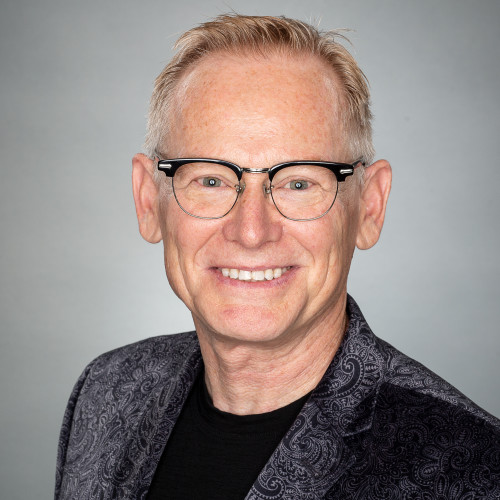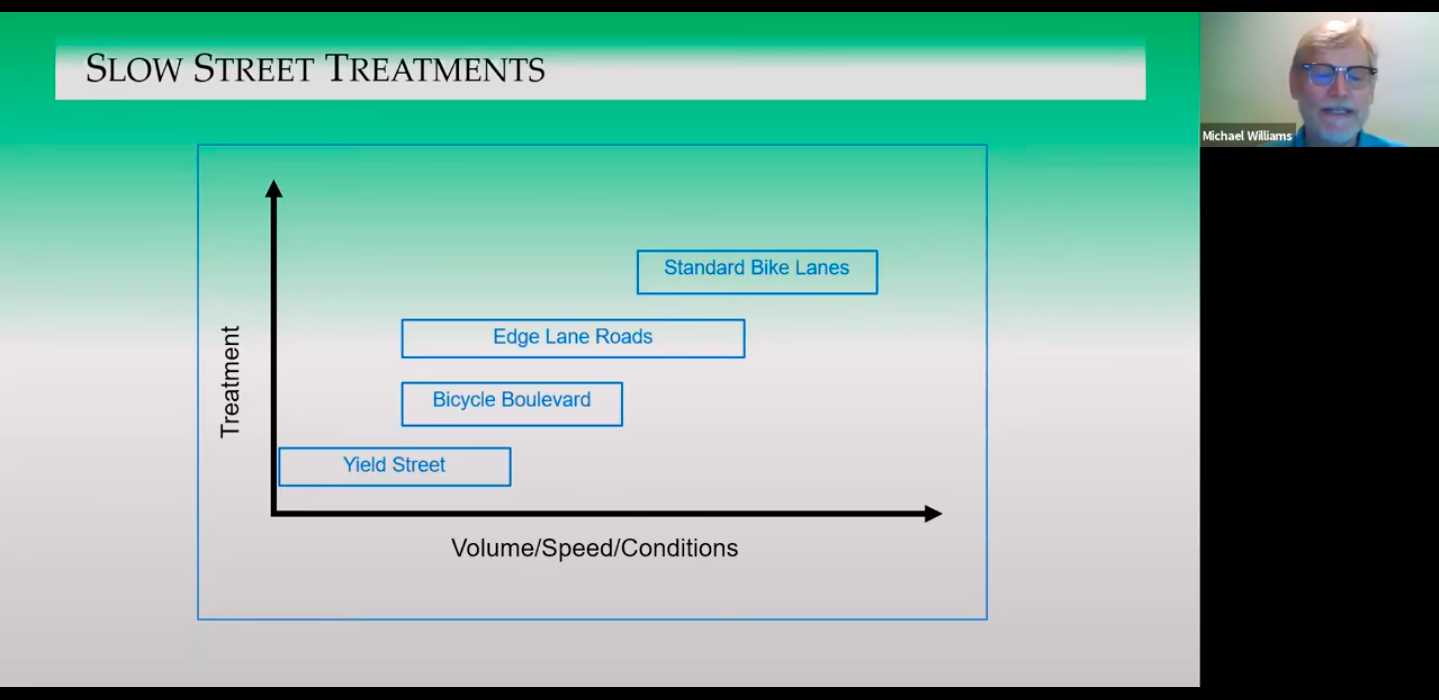News | Transportation Consultant Michael Williams Outlines the History and Benefits of Edge Lane Roads
Stop the VideoNews

PSR
Transportation Consultant Michael Williams Outlines the History and Benefits of Edge Lane Roads
Thursday, June 11, 2020
by Malak Saleh, Environmental Science and Management, UC Davis
Michael Williams, owner of Michael Williams Company, a transportation consulting firm, was the featured speaker of the seminar entitled, “Edge Lane Roads - A New Type of Shared Road for All Vulnerable Road Users.” Williams began his presentation by defining edge lane roads (ELRs)—a road structure that is rare in the United States—and how they operate.

Edge lane roads, also known as “Advisory Bike Lanes” or “Advisory Shoulders,” are a road configuration which lie between a shared street and standard bike lanes. They are composed of a single centered lane (which supports two-way motor vehicle traffic), accompanied by two wide lanes on either side of the center lane reserved for pedestrian and/or bicycle traffic. Motor vehicles pass by one another in the center lane by moving into the edge lanes and returning to the center lane afterwards.
As Williams puts it, there are many benefits to establishing ELRs on low and mid-level speed roads. These roads make room for vulnerable road users on each side of the center lane, and they prioritize space for bicyclists and pedestrians. They also make it easier and safer for bicyclists to bike side by side, and, as Williams explained, they do not require widening of already existing roads. While the U.S. has only seen 35 installations of ELRs thus far, Williams pointed out several advantages of these roads, including reductions in crash rates, reductions in motor vehicle speeds, reductions in motor vehicle volume, and the elimination of head-on collisions.

While ELRs are relatively new in the U.S.—the first installation occurred in 2011—they are familiar to many European nations, several of which implemented ELRs into their road systems in the 1970s. ELRs in Europe have supported over 92 million vehicle trips, and, as Williams stressed, they have done so while providing facilities for vulnerable road users, calming traffic, retaining necessary space for motor vehicles, and reducing the rate of road degradation by moving heavy vehicles from the fragile edges of roads to their more robust centers. Williams touched on the barriers to installing ELRs in the U.S., including lack of guidance, legal ambiguity, lack of domestic experience, and the experimental status assigned to ELRs by the Federal Highway Safety Administration.
In Williams’ view, ELRs are “better than bike lanes” and superior to “bike boulevards.” Traditional bike lanes often fail to incorporate enough space for parked cars to open their doors safely, whereas edge lanes provide added space that buffers between bicyclists and car users. Williams also pointed out how ELRs provide space for bicyclists and pedestrians on roads that may not otherwise get bike lanes or sidewalks added to them for decades—a reality on many rural roads. Furthermore, unlike bike boulevards, edge lanes eliminate the need for motorists to merge around bicyclists or follow closely behind bicyclists.
-0.png)
As he finished his presentation, Williams highlighted the benefits ELRs could bring to rural roads. Rural high speed roads serve just 19% of the U.S. population, but see 54% of vehicular fatalities. Edge lane roads could serve as an alternative to widening roadways, and could help drop motor vehicle speeds, potentially reducing crash rates by 24 to 59%.
Michael Williams is the Owner of Michael Williams Company, a transportation consulting firm specializing in active transportation, traffic calming, rural environments, public works construction, roundabouts, and road diets. Michael has been involved in the planning and design of active transportation facilities for more than 15 years. In addition to fifteen years as a licensed public works general contractor, he holds three engineering degrees and has been awarded more than ten patents. Michael is a member of APBP and ITE.
You can view a full recording of Michael Williams’ talk, part of ITS-Davis’ weekly seminar series, on YouTube here.
Author Malak Saleh is a student assistant at the National Center for Sustainable Transportation.
News Archive
- December (1)
- November (6)
- October (4)
- September (2)
- August (3)
- July (4)
- June (3)
- May (7)
- April (8)
- March (11)
- February (8)
- January (7)
- December (7)
- November (8)
- October (11)
- September (11)
- August (4)
- July (10)
- June (9)
- May (2)
- April (12)
- March (8)
- February (7)
- January (11)
- December (11)
- November (5)
- October (16)
- September (7)
- August (5)
- July (13)
- June (5)
- May (5)
- April (7)
- March (5)
- February (3)
- January (4)
- December (4)
- November (5)
- October (5)
- September (4)
- August (4)
- July (6)
- June (8)
- May (4)
- April (6)
- March (6)
- February (7)
- January (7)
- December (8)
- November (8)
- October (8)
- September (15)
- August (5)
- July (6)
- June (7)
- May (5)
- April (8)
- March (7)
- February (10)
- January (12)















